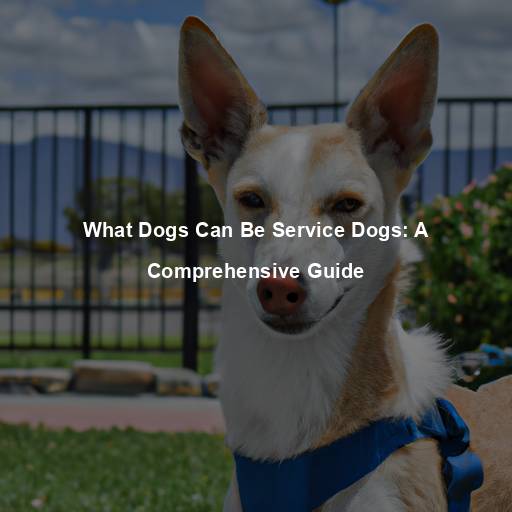What Dogs Can Be Service Dogs: A Comprehensive Guide
Last Updated on July 17, 2023 by Evan
Contents [hide]
- 1 Understanding Service Dogs
- 1.1 Types of Service Dogs
- 1.2 Characteristics of a Suitable Service Dog
- 1.3 Breeds Commonly Used as Service Dogs
- 1.4 The Importance of Specialized Training
- 1.5 Legal Rights and Access
- 1.6 The Bond Between a Service Dog and Its Handler
- 1.7 The Difference Between Service Dogs and Emotional Support Animals
- 1.8 The Future of Service Dogs
- 1.9 Selecting Potential Service Dogs
- 1.10 Early Socialization and Basic Obedience Training
- 1.11 Task-Specific Training
- 1.12 Public Access Training
- 1.13 Handler Training and Team Bonding
- 1.14 Recertification and Ongoing Training
- 2 The Impact of Service Dogs on Individuals with Disabilities
- 3 The Ethics and Responsibilities of Service Dog Ownership
- 4 FAQs – What Dogs Can Be Service Dogs
Understanding Service Dogs
In a world filled with constant challenges, it’s a breath of fresh air to witness the unwavering loyalty and indescribable bond between individuals with disabilities and their service dogs. These four-legged heroes are more than just companions; they are lifesavers, offering a helping paw in a myriad of ways. From guiding the visually impaired through bustling streets to alerting the deaf to important sounds, these remarkable canines possess an innate ability to make the impossible possible. However, not every dog is destined for this noble calling.
Types of Service Dogs
When it comes to service dogs, their abilities and the assistance they provide can leave you pleasantly astounded. These remarkable creatures can be categorized into various types based on the kind of support they offer. Brace yourself for the awe-inspiring world of service dogs as we delve into some of the most common types you may encounter.
- Guide Dogs: Guide dogs, also known as seeing-eye dogs, are trained to assist individuals with visual impairments or blindness. These dogs help navigate their handlers through obstacles, traffic, and other hazards, providing a sense of independence and safety.
Discover the amazing world of Hearing Dogs, these awe-inspiring companions are specially trained to offer invaluable assistance to individuals who are deaf or hard of hearing. With their heightened senses and unwavering dedication, these furry superheroes alert their handlers to crucial sounds like doorbells, alarms, or even the approach of vehicles, thereby elevating their overall environmental awareness to astounding levels. Prepare to be captivated by their extraordinary abilities and the profound impact they have on the lives of those they support.
- Mobility Assistance Dogs: Dogs in this category are trained to assist individuals with mobility limitations, such as those who use wheelchairs or have balance issues. They can retrieve objects, open doors, and provide stability and support while walking or climbing stairs.
Unleash the extraordinary world of medical alert dogs, those fur-clad heroes who possess an impeccable talent for detecting subtle shifts in their owners’ body chemistry and behavior. With unparalleled intuition, they become the dependable allies for individuals facing the unpredictable challenges of diabetes, epilepsy, or severe allergies. These loyal companions serve as vigilant sentinels, fearlessly alerting their human partners to any lurking health emergencies, empowering them to take immediate action or reach out for timely assistance.
Characteristics of a Suitable Service Dog
Not every dog possesses the qualities necessary to become a successful service dog. Here are some key characteristics that make a dog suitable for service dog work:
When it comes to temperament, service dogs boast an unruffled disposition that sets them apart. These incredible canines exude warmth, demonstrating unwavering patience and maintaining their composure effortlessly, no matter the circumstances or surroundings. Their affable nature and ability to navigate diverse environments truly make them the epitome of steady companionship.
- Intelligence: Service dogs need to be highly intelligent and trainable. They should be able to learn and execute complex commands reliably and consistently.
When it comes to selecting dogs for service dog duties, their physical prowess is of utmost importance. These remarkable canines must demonstrate the innate ability to carry out a myriad of tasks tailored to their designated roles. Whether it entails leading the way, fetching objects, or providing invaluable physical assistance, their physical makeup must align with these demanding responsibilities.
Ensuring optimal health for service dogs is paramount as they embrace their duties with unwavering dedication. Prioritizing their well-being necessitates regular visits to skilled veterinarians and diligent healthcare practices. By addressing any potential obstacles that might impede their exceptional abilities, we pave the way for these remarkable companions to thrive and fulfill their noble roles.
When it comes to the world of service dogs, there is no one-size-fits-all approach. These remarkable companions come in a diverse array of sizes and structures, tailored to suit the specific tasks they will undertake. Take guide dogs, for instance, who tend to fall within the medium to large-size range, representing a perfect blend of strength and agility. On the other hand, when it comes to mobility assistance dogs, brawn may outweigh burliness, as their duties demand a sturdier presence.
Breeds Commonly Used as Service Dogs
When it comes to selecting service dogs, the choices are as diverse as the breeds themselves. From the tenacious Terriers to the agile and alert Retrievers, a myriad of different breeds make the cut based on their unique blend of temperament, intelligence, and physical prowess. These chosen few possess an unparalleled ability to assist and support individuals in need, making a profound difference in the lives they touch. Without further ado, let’s explore some of the notable breeds that frequently grace the ranks of service dogs.
Labrador Retrievers have truly captured the hearts of dog lovers everywhere, standing tall as a beloved favorite in the realm of service dog breeds. Renowned for their remarkable intelligence and unwavering trainability, these magnificent canines possess a natural charm that effortlessly melts the hearts of all they encounter. These four-legged superstars are versatile in nature, flawlessly adapting to a myriad of service dog roles with their affable demeanor and innate ability to connect on a deep level with those in need.
-
Golden Retrievers: Golden Retrievers possess similar qualities to Labrador Retrievers and are often chosen for their friendly and gentle nature. They excel in roles such as therapy dogs, guide dogs, and medical alert dogs.
-
German Shepherds: German Shepherds are known for their intelligence, loyalty, and versatility. They are often utilized as guide dogs, mobility assistance dogs, and search and rescue dogs.
-
Poodles: Poodles are highly intelligent and adaptable dogs that come in different sizes, including standard, miniature, and toy. Their hypoallergenic coat makes them suitable for individuals with allergies, and they are often used as hearing dogs or medical alert dogs.
Border Collies truly embody the epitome of canine brilliance. These magnificent creatures possess a remarkable intellect, unmatched agility, and an uncanny ability to absorb knowledge like sponges. Admired by experts and enthusiasts alike, these astute animals flourish in occupations that demand exceptional problem-solving prowess, such as guiding individuals with visual impairments or providing invaluable assistance to those on the autism spectrum.
The Importance of Specialized Training
Making the transition to becoming a service dog is no walk in the park; it’s a journey that involves intense training to ensure these remarkable canines are up to the task. Through carefully designed programs, they master the arts of obedience, learn specialized skills, get acquainted with different social settings, and polish their ability to navigate the public sphere seamlessly. The key to their success lies in their ability to remain cool, calm, and collected amidst a barrage of distractions while responding swiftly to the commands of their dedicated handlers.
Legal Rights and Access
Navigating the intricate web of regulations and allowances surrounding service dogs can often leave individuals awestruck. In the sprawling expanse of the United States, for instance, the Americans with Disabilities Act (ADA) manifests as the guardian angel of those with disabilities, safeguarding the presence of their indispensable service dogs in public spaces. Yet, while these celestial laws grant protection, it behooves service dog handlers to delve into the labyrinthine realm of their rights and responsibilities, ensuring a harmonious and dignified engagement with the wider public.
The Bond Between a Service Dog and Its Handler
The extraordinary bond and trust shared between a service dog and its handler create a profound connection that defies conventional understanding. These remarkable canines seamlessly integrate into their handlers’ lives, offering not only indispensable practical aid, but also an unwavering source of emotional solace and unconditional companionship. Their unwavering dedication and loyalty play an instrumental role in nurturing their handlers’ well-being and fostering a newfound sense of independence. The intricate dynamics of this unique relationship are a testament to the profound impact service dogs have on enhancing the lives of those they assist.
The Difference Between Service Dogs and Emotional Support Animals
Understanding the distinction between service dogs and emotional support animals (ESAs) is crucial. Service dogs undergo rigorous training to perform specialized tasks that aid individuals with disabilities, whereas ESAs offer invaluable comfort, companionship, and emotional support to those with mental health conditions. It is worth noting that ESAs do not enjoy the same legal privileges and access as their service dog counterparts, and the regulations surrounding their presence in public spaces may differ. The contrasting roles and regulations of these remarkable animals can be perplexing, yet appreciating their unique contributions is indispensable.
The Future of Service Dogs
As our society progresses in terms of understanding disabilities and recognizing the invaluable contributions of service dogs, we can anticipate a flurry of innovations in training practices, robust support networks, and comprehensive legal structures. The horizon is bright with possibilities, paving the way for enhanced inclusivity, heightened awareness, and broader avenues for individuals with disabilities to embrace lives brimming with fulfillment, with their loyal service dogs by their side.
After surveying a multitude of individuals with disabilities and their beloved service dogs, a resounding truth emerged: these remarkable creatures have an undeniable impact on their handlers’ lives. With their distinct abilities, honed through specialized training, service dogs provide an invaluable level of support and companionship that words can scarcely capture. To truly foster a more inclusive society, it is imperative that we delve into the depths of knowledge surrounding the different types of service dogs, their unique characteristics, and the legal rights that accompany their vital roles. Only then can we begin to unravel the complexities and embrace the perplexing beauty of these extraordinary animals.
Selecting Potential Service Dogs
When it comes to training a service dog, the first step is all about finding the perfect match. The organizations responsible for this incredible task have a meticulous process in place, with a set of criteria that would perplex even the canniest of canines. From assessing temperament to measuring intelligence, evaluating physical abilities to scrutinizing health, every factor plays a vital role. And let’s not forget the intriguing twist of breed characteristics, as certain breeds find themselves in the spotlight for particular service dog roles.
Early Socialization and Basic Obedience Training
When it comes to preparing a promising service dog prospect, the journey begins with an intricate dance of socialization and basic obedience training. This intricate interplay cultivates a strong foundation of positive behavior and emotional agility, enabling the dog to gracefully navigate diverse environments, interact with a tapestry of individuals, and effortlessly coexist with their furry counterparts. The initial phase of socialization seamlessly intertwines the threads of adaptability, acquainting the doggie luminary with the wide spectrum of experiences that await them. Subsequently, the symphony of basic obedience training commences, orchestras of essential commands such as sit, stay, come, and heel guiding the future champion paw by paw, laying the groundwork for their harmonious progression in the realms of advanced instruction.
Task-Specific Training
Once the fundamental foundations of obedience have been firmly established, the canine journey embarks upon a captivating twist – task-specific training. This intricate process ingeniously tailors the training regimen to the unique role each individual dog will ultimately fulfill as a devoted service companion. Picture, if you will, the extraordinary journey of guide dogs, who gracefully traverse treacherous obstacles, halt dutifully at curbs, and adeptly guide their human counterparts through the ever-changing tapestry of environments. Meanwhile, their harmonious counterparts, the hearing dogs, adroitly respond to the symphony of sounds surrounding them, diligently alerting their guardians to the pertinent signals.
Public Access Training
The art of public access training is an absolute must in the world of service dog training. It dives deep into the intricate realm of teaching our furry companions to exhibit impeccable behavior in bustling public domains, all while marching to the rhythm of their handler’s command amid a never-ending symphony of distractions. Through this training, dogs master the art of strolling serenely on a leash, nonchalantly disregarding the tantalizing allure of food and other tempting delights, all the while radiating an air of sophistication and impeccable manners in the midst of crowded spaces.
Handler Training and Team Bonding
When it comes to service dogs, it’s not just the four-legged companions who need training. Handlers play a crucial role in this intricate dance, and they undergo rigorous training themselves. From mastering the art of reinforcing commands to managing their canine sidekicks’ behavior, handlers are equipped with the tools they need to tackle any challenges that come their way. Through this mutual education, a powerful connection is formed, allowing an unbreakable bond to flourish between the human and furry halves of the team, paving the way for a fruitful partnership.
Recertification and Ongoing Training
Service dogs and their devoted handlers are no strangers to the continuous pursuit of excellence. With a zest for lifelong learning, they engage in regular recertification processes that keep their skills finely honed and relevant. These ongoing training sessions and rigorous evaluations serve as a crucible that sharpens the dog’s proficiency, fostering an unbreakable bond with their unwavering human companion. Beyond embodying the epitome of dedication, these training sessions offer an invaluable platform for handlers to address any behavioral challenges and navigate novel tasks or environments with unwavering grace and adaptability.
The Impact of Service Dogs on Individuals with Disabilities
Have you ever witnessed the transformative power of service dogs? These incredible creatures go beyond their practical duties to become invaluable companions to individuals with disabilities, bestowing upon them a sense of independence that was previously unimaginable. Their impact is felt on a profound level, as they not only offer support but also enhance their handlers’ overall well-being. Let’s explore the myriad ways in which these remarkable service dogs change lives, fostering a newfound sense of freedom and empowerment.
Increased Mobility and Independence
Imagine the freedom of being able to navigate your world with a loyal companion by your side, ready to help with everyday tasks. Whether it’s opening doors, fetching items, or even providing physical support while scaling stairs, service dogs are the ultimate partners in independence for those with limited mobility. By lending a helping paw, these incredible canines empower individuals to navigate their surroundings with newfound confidence, breaking down barriers and reducing the need for constant assistance.
Enhanced Safety and Security
Service dogs are trained to detect potential dangers and alert their handlers to potential hazards. For individuals with visual impairments, guide dogs provide a reliable and trustworthy companion, helping them navigate busy streets, cross roads, and avoid obstacles. Hearing dogs alert individuals with hearing loss to important sounds, ensuring they are aware of potential dangers or emergencies in their environment.
Emotional Support and Companionship
Discover the remarkable world of service dogs, where unwavering companionship meets unparalleled emotional support. These extraordinary canines weave themselves into the very fabric of their handlers’ lives, serving as reliable confidants and loyal confidantes. In an enchanting display of unconditional love, service dogs alleviate the burdens of loneliness, anxiety, and depression, offering a respite for the soul and nurturing emotional well-being in profound ways. Prepare to be captivated by these astonishing creatures and the transformative impact they have on the human spirit.
Increased Social Interaction
Service dogs play a pivotal role as social catalysts, bridging the divide and fostering connections for those navigating the challenges of disability. With their ever-present companionship, service dogs become the key that unlocks conversations and kindles interactions, smashing the barriers that confine individuals. Through these serendipitous encounters, a world of understanding and enlightenment unfold as they enlighten and educate others about the power of service dogs and the intricate intricacies of living with a disability. The ripples of these encounters ripple outwards, creating waves of inclusion and embracing acceptance within the very fabric of their communities.
Improved Quality of Life
Ultimately, service dogs significantly improve the overall quality of life for individuals with disabilities. By assisting with daily tasks, providing emotional support, and promoting independence, service dogs empower individuals to live more fulfilling and meaningful lives. These remarkable animals contribute to the physical, emotional, and social well-being of their handlers, fostering a greater sense of self-confidence, happiness, and overall life satisfaction.
The Ethics and Responsibilities of Service Dog Ownership
Owning and working with a service dog comes with certain ethical considerations and responsibilities. It is essential for both service dog handlers and the general public to understand these aspects to ensure a harmonious and respectful environment for everyone involved.
Public Etiquette and Respect
In today’s society, it is of utmost importance that we recognize and honor the vital role service dogs and their handlers play. These incredible animals are not just cute companions, but dedicated working professionals who provide invaluable services to individuals with disabilities. We must refrain from indulging our natural instincts to pet, distract, or approach them without permission, as it could potentially jeopardize their crucial tasks and ultimately compromise their safety and well-being. Let us embrace this knowledge and respect the important boundaries that exist to ensure the seamless functionality of these exceptional partnerships.
Education and Awareness
In our quest for a more inclusive society, it is crucial to recognize the pivotal role education and awareness play in unraveling the complexities surrounding service dogs and the rights of individuals with disabilities. By embarking on conversations that are both open-minded and respectful, service dog handlers have the power to shed light on the indispensable role these remarkable animals play in enhancing the lives of their owners. Meanwhile, the onus lies on the general public to proactively equip themselves with knowledge about service dogs and the etiquettes required when in their presence, thereby breaking down misconceptions and dismantling stereotypes that hinder genuine understanding.
Proper Care and Well-being
Service dog handlers have the responsibility to ensure the proper care and well-being of their service dogs. This includes providing regular veterinary care, appropriate nutrition, and exercise. Handlers should also prioritize the mental and emotional well-being of their dogs by providing adequate mental stimulation, rest, and opportunities for play and relaxation.
Advocacy and Accessibility
As society becomes more conscious of the diverse needs of individuals with disabilities, service dog handlers play a crucial role in championing accessibility and inclusivity. With their first-hand experiences and unwavering commitment, these remarkable individuals have the power to create a profound impact on public spaces. By bravely sharing their personal stories and dedicating themselves to advocacy, service dog handlers can inspire transformative changes in policies and attitudes, propelling us towards a more inclusive and accepting world.
Commitment and Partnership
Having a service dog is a profound and ongoing responsibility that demands unwavering dedication. It’s not just about the initial training; it’s about nurturing an enduring bond and upholding consistent care throughout the dog’s life. By engaging in regular training sessions, participating in activities that strengthen the connection, and firmly reinforcing commands, the service dog-handler duo can navigate life’s complexities with unwavering success. It’s a journey that is both challenging and rewarding, requiring a steadfast commitment to creating a harmonious partnership.
FAQs – What Dogs Can Be Service Dogs
What breeds of dogs can be service dogs?
Service dogs can come from a wide range of breeds. While some breeds are more commonly trained to become service dogs, such as Labrador Retrievers, Golden Retrievers, and German Shepherds, the breed alone does not determine a dog’s ability to become a service dog. It is more important to focus on the individual dog’s temperament, intelligence, and trainability rather than its breed.
Can mixed breed dogs be service dogs?
Yes, mixed breed dogs can absolutely be service dogs. In fact, many successful service dogs are mixed breeds. Just like purebred dogs, the key factors to consider when determining if a mixed breed dog can be a service dog are their temperament, intelligence, and trainability. If a mixed breed dog has the necessary characteristics and can fulfill the specific tasks required of a service dog, they can be trained and certified as service dogs.
Can small dogs be service dogs?
It’s quite the perplexing notion, but believe it or not, small dogs can indeed be trained to take on the prestigious role of service dogs. Bursting with potential, these petite pooches prove that size is but a mere detail. Yorkshire Terriers, Miniature Poodles, and even Chihuahuas have demonstrated remarkable capabilities as service dogs after undergoing the necessary training and certification. However, it’s crucial to remain cognizant of the fact that certain tasks may pose more of a challenge for these diminutive canines, given their size and physical limitations. Hence, it becomes imperative to custom-tailor the assigned tasks to align with the unique abilities of these pint-sized service dogs.
Are there any specific characteristics that service dogs should possess?
A successful service dog embodies key traits that empower them to excel in their invaluable duties. A serene and affable disposition, combined with a remarkable aptitude for learning, forms the bedrock of their effectiveness. Furthermore, an unwavering commitment to their tasks, even amidst chaos and pressure, showcases their unwavering work ethic. Flexibility and adaptability, coupled with a poised self-assurance, equip these remarkable canines to gracefully navigate diverse scenarios and effortlessly embrace novel adventures.
Can any dog become a service dog?
Not every dog can become a service dog. To be successful, service dogs require a specific combination of traits that make them suitable for their role. They should have a natural willingness to please, be intelligent, and have a strong desire to work and assist their handler. Additionally, they need to be healthy and physically capable of performing the tasks required of them. However, with proper training, even dogs that do not meet these criteria can still excel in other roles, such as therapy dogs or emotional support animals.







